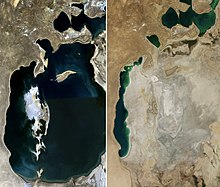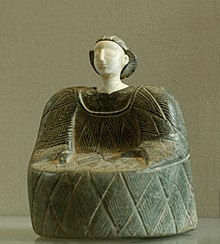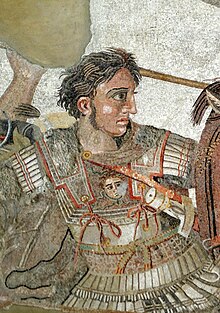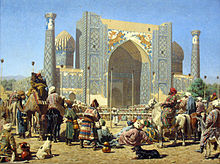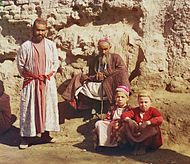Uzbekistan
Republic of Uzbekistan | |
|---|---|
Anthem: "Oʻzbekiston Respublikasining Davlat Madhiyasi" (English: "State Anthem of the Republic of Uzbekistan") | |
 Location of Uzbekistan (green) | |
| Capital and largest city | Tashkent 41°19′N 69°16′E |
| Official languages | Uzbek, Russian (de-facto)[2][3][4] |
| Ethnic groups |
|
| Religion |
|
| Demonym(s) | Uzbek |
| Government | Unitary presidentialconstitutional republicunder an authoritarian state[6] |
| Shavkat Mirziyoyev | |
| Abdulla Aripov | |
• Chairman of the Senate | Nigmatilla Yuldashev |
| Legislature | Supreme Assembly |
| Senate | |
| Legislative Chamber | |
| Formation | |
• Emirate of Bukharaproclaimed | 1785 |
• Bukharan People's Soviet Republicestablished | 30 April 1920 |
• Uzbek SSRestablished after national delimitation | 27 October 1924 |
• Declared independence from the Soviet Union | 31 August 1991 |
• Formally recognised | 26 December 1991 |
| 2 March 1992 | |
| 8 December 1992 | |
| Area | |
• Total | 448,978 km2(173,351 sq mi) (56th) |
• Water (%) | 4.9 |
| Population | |
• 2019 estimate | 33,254,100[7] (41nd) |
• Density | 74.1/km2 (191.9/sq mi) (132nd) |
| GDP (PPP) | 2018 estimate |
• Total | $238.997 billion[8] (62) |
• Per capita | $7,350[8] (125th) |
| GDP (nominal) | 2018 estimate |
• Total | $40.259 billion[8] (69th) |
• Per capita | $1,238[8] (130th) |
| Gini (2013) | medium · 88th |
| HDI (2018) | high · 105th |
| Currency | Uzbek som (UZS) |
| Time zone | UTC+5 (UZT) |
| Driving side | right |
| Calling code | +998 |
| ISO 3166 code | UZ |
| Internet TLD | .uz |
Uzbekistan (US: /ʊzˈbɛkɪstæn, ![]() listen), UK: /ʊzˌbɛkɪˈstɑːn,
listen), UK: /ʊzˌbɛkɪˈstɑːn,
What is now Uzbekistan was in ancient times part of the Iranian-speaking region of Transoxiana and Turan. The first recorded settlers were Eastern Iranian nomads, known as Scythians, who founded kingdoms in Khwarezm (8th–6th centuries BC), Bactria (8th–6th centuries BC), Sogdia (8th–6th centuries BC), Fergana (3rd century BC – 6th century AD), and Margiana (3rd century BC – 6th century AD). The area was incorporated into the Persian Empire and, after a period of Macedonian Greek rule, was ruled by the Persian Parthian Empire and later by the Sasanian Empire, until the Muslim conquest of Persia in the 7th century. The Muslim conquest in the 7th century converted the majority of the population, including the local ruling classes, into adherents of Islam. During this period, cities such as Samarkand, Khiva and Bukhara began to grow rich from the Silk Road. The local Khwarezmian dynasty, and Central Asia as a whole, were decimated by the Mongol invasion in the 13th century. After the Mongol Conquests, the area became increasingly dominated by Turkic peoples. The city of Shahrisabz was the birthplace of the Turco-Mongol warlord Timur, also known as one of Genghis Khan's grandchildren, who in the 14th century established the Timurid Empire and was proclaimed the Supreme Emir of Turan with his capital in Samarkand. The area was conquered by Uzbek Shaybanids in the 16th century, moving the centre of power from Samarkand to Bukhara. The region was split into three states: Khanate of Khiva, Khanate of Kokand, and Emirate of Bukhara. It was gradually incorporated into the Russian Empire during the 19th century, with Tashkent becoming the political center of Russian Turkestan. In 1924, after national delimitation, the constituent republic of the Soviet Union known as the Uzbek Soviet Socialist Republic was created. Following the breakup of the Soviet Union, it declared independence as the Republic of Uzbekistan on 31 August 1991.
Uzbekistan has a diverse cultural heritage due to its storied history and strategic location. Its first major official language is Uzbek, a Turkic language written in the Latin alphabet and spoken natively by approximately 85% of the population. Russian has widespread use as a governmental language; it is the most widely taught second language. Uzbeks constitute 81% of the population, followed by Russians (5.4%), Tajiks (4.0%), Kazakhs (3.0%), and others (6.5%). Muslims constitute 79% of the population while 5% of the population follow Russian Orthodox Christianity, and 16% of the population follow other religions or are non-religious. A majority of Uzbeks are non-denominational Muslims.[12] Uzbekistan is a member of the CIS, OSCE, UN, and the SCO. While officially a democratic republic,[13] by 2008 non-governmental human rights organizations defined Uzbekistan as "an authoritarian state with limited civil rights".[14]
Following the death of Islam Karimov in 2016, the second president, Shavkat Mirziyoyev, started a new course, which was described as a A Quiet Revolution and Revolution from Above. He stated he intended to abolish cotton slavery, systematic use of child labour,[15] exit visas, to introduce a tax reform, create four new free economic zones, as well as amnestied some political prisoners. The relations with neighboring countries of Tajikistan, Kyrgyzstan and Afghanistan drastically improved.[16][17][18][19] However, the Amnesty International report on human rights in the country for 2017/2018 described continued repressive measures, including forced labour in cotton harvesting, and restrictions on movements of 'freed' prisoners.[20]
The Uzbek economy is in a gradual transition to the market economy, with foreign trade policy being based on import substitution. In September 2017, the country's currency became fully convertible in the market rates. Uzbekistan is a major producer and exporter of cotton. The country also operates the largest open-pit gold mine in the world. With the gigantic power-generation facilities of the Soviet era and an ample supply of natural gas, Uzbekistan has become the largest electricity producer in Central Asia.[21]Renewable energy constitutes more than 23% of the country's energy sector, with hydroelectricity and solar energy having 21.4% and 2% respectively.
Contents
Geography
Uzbekistan has an area of 447,400 square kilometres (172,700 sq mi). It is the 56th largest country in the world by area and the 42nd by population.[22] Among the CIS countries, it is the 4th largest by area and the 2nd largest by population.[23]
Uzbekistan lies between latitudes 37° and 46° N, and longitudes 56° and 74° E. It stretches 1,425 kilometres (885 mi) from west to east and 930 kilometres (580 mi) from north to south. Bordering Kazakhstan and the Aralkum Desert (former Aral Sea) to the north and northwest, Turkmenistan and Afghanistan to the southwest, Tajikistan to the southeast, and Kyrgyzstan to the northeast, Uzbekistan is one of the largest Central Asian states and the only Central Asian state to border all the other four. Uzbekistan also shares a short border (less than 150 km or 93 mi) with Afghanistan to the south.
Uzbekistan is a dry, landlocked country. It is one of two doubly landlocked countries in the world (that is, a country completely surrounded by landlocked countries), the other being Liechtenstein. In addition, due to its location within a series of endorheicbasins, none of its rivers lead to the sea. Less than 10% of its territory is intensively cultivated irrigated land in river valleys and oases. The rest is vast desert (Kyzyl Kum) and mountains.
The highest point in Uzbekistan is the Khazret Sultan, at 4,643 metres (15,233 ft) above sea level, in the southern part of the Gissar Range in Surkhandarya Province, on the border with Tajikistan, just northwest of Dushanbe (formerly called Peak of the 22nd Congress of the Communist Party).[23]
The climate in Uzbekistan is continental, with little precipitation expected annually (100–200 millimetres, or 3.9–7.9 inches). The average summer high temperature tends to be 40 °C (104 °F), while the average winter low temperature is around −23 °C (−9 °F).[24]
Environment
Uzbekistan has a rich and diverse natural environment. However, decades of questionable Soviet policies in pursuit of greater cotton production have resulted in a catastrophic scenario with the agricultural industry being the main contributor to the pollution and devastation of both air and water in the country.[25]
The Aral Sea used to be the fourth-largest inland sea on Earth, acting as an influencing factor in the air moisture and arid land use.[26] Since the 1960s, the decade when the overuse of the Aral Sea water began, it has shrunk to about 10% of its former area and divided into parts, with only the southern part of the narrow western lobe of the South Aral Sea remaining permanently in Uzbekistan. Reliable, or even approximate data, have not been collected, stored or provided by any organization or official agency.[citation needed]Much of the water was and continues to be used for the irrigation of cotton fields, a crop requiring a large amount of water to grow.[27]
Due to the Aral Sea problem, high salinity and contamination of the soil with heavy elements are especially widespread in Karakalpakstan, the region of Uzbekistan adjacent to the Aral Sea. The bulk of the nation's water resources is used for farming, which accounts for nearly 84% of the water usage and contributes to high soil salinity. Heavy use of pesticides and fertilizers for cotton growing further aggravates soil contamination.[24]
According to the UNDP (United Nations Development Program), climate risk management in Uzbekistan needs to consider its ecological safety.[28]
History
The first people known to have inhabited Central Asia were Scythians who came from the northern grasslands of what is now Uzbekistan, sometime in the first millennium BC; when these nomads settled in the region they built an extensive irrigation system along the rivers.[29] At this time, cities such as Bukhoro (Bukhara) and Samarqand (Samarkand) emerged as centres of government and high culture.[29] By the fifth century BC, the Bactrian, Soghdian, and Tokharian states dominated the region.[29]
As China began to develop its silk trade with the West, Persian cities took advantage of this commerce by becoming centres of trade. Using an extensive network of cities and rural settlements in the province of Transoxiana, and further east in what is today China's Xinjiang Uygur Autonomous Region, the Sogdian intermediaries became the wealthiest of these Iranian merchants. As a result of this trade on what became known as the Silk Route, Bukhara and Samarkand eventually became extremely wealthy cities, and at times Transoxiana (Mawarannahr) was one of the most influential and powerful Persian provinces of antiquity.[29]
In 327 BC Macedonian ruler Alexander the Great conquered the Persian Empire provinces of Sogdiana and Bactria, which contained the territories of modern Uzbekistan. A conquest was supposedly of little help to Alexander as popular resistance was fierce, causing Alexander's army to be bogged down in the region that became the northern part of the Macedonian Greco-Bactrian Kingdom. The kingdom was replaced with the Yuezhi dominated Kushan Empire in the 1st century BC. For many centuries the region of Uzbekistan was ruled by the Persian empires, including the Parthian and Sassanid Empires, as well as by other empires, for example those formed by the Turko-Persian Hephthalite and Turkic Gokturk peoples.
In the 8th century, Transoxiana, the territory between the Amudarya and Syrdarya rivers, was conquered by the Arabs (Ali ibn Sattor) who enriched the region with the Early Renaissance. Many notable scientists lived there and contributed to its development during the Islamic Golden Age. Among the achievements of the scholars during this period were the development of trigonometry into its modern form (simplifying its practical application to calculate the phases of the moon), advances in optics, in astronomy, as well as in poetry, philosophy, art, calligraphy and many others, which set the foundation for the Muslim Renaissance.[citation needed]
In the 9th and 10th centuries, Transoxiana was included into the Samanid State. Later, Transoxiana saw the incursion of the Turkic-ruled Karakhanids, as well as the Seljuks(Sultan Sanjar) and Kara-Khitans.[30]
The Mongol conquest under Genghis Khan during the 13th century would bring about a change to the region. The Mongol invasion of Central Asia led to the displacement of some of the Iranian-speaking people of the region, their culture and heritage being superseded by that of the Mongolian-Turkic peoples who came thereafter. The invasions of Bukhara, Samarkand, Urgench and others resulted in mass murders and unprecedented destruction, such as portions of Khwarezmia being completely razed.[31]
Following the death of Genghis Khan in 1227, his empire was divided among his four sons and his family members. Despite the potential for serious fragmentation, the Mongol law of the Mongol Empire maintained orderly succession for several more generations, and control of most of Transoxiana stayed in the hands of the direct descendants of Chagatai Khan, the second son of Genghis Khan. Orderly succession, prosperity, and internal peace prevailed in the Chaghatai lands, and the Mongol Empire as a whole remained a strong and united kingdom (Ulus Batiy, Sattarkhan).[32]
During this period, most of present Uzbekistan was part of the Chagatai Khanate except Khwarezm was part of the Golden Horde. After the decline of the Golden Horde, Khwarezm was briefly ruled by the Sufi Dynasty till Timur's conquest of it in 1388.[33] Sufids rules Khwarezm as vassals of alternatively Timurids, Golden Horde and Uzbek Khanate till Persian occupation in 1510.
In the early 14th century, however, as the empire began to break up into its constituent parts. The Chaghatai territory was disrupted as the princes of various tribal groups competed for influence. one tribal chieftain, Timur (Tamerlane),[34] emerged from these struggles in the 1380s as the dominant force in Transoxiana. Although he was not a descendant of Genghis Khan, Timur became the de facto ruler of Transoxiana and proceeded to conquer all of western Central Asia, Iran, the Caucasus, Mesopotamia, Asia Minor, and the southern steppe region north of the Aral Sea. He also invaded Russia before dying during an invasion of China in 1405.[32]
Timur was known for his extreme brutality and his conquests were accompanied by genocidal massacres in the cities he occupied.[35]
Timur initiated the last flowering of Transoxiana by gathering together numerous artisans and scholars from the vast lands he had conquered into his capital, Samarqand. By supporting such people, he imbued his empire with a rich Perso-Islamic culture. During his reign and the reigns of his immediate descendants, a wide range of religious and palatial construction masterpieces were undertaken in Samarqand and other population centres.[36] Amir Timur initiated an exchange of medical discoveries and patronized physicians, scientists and artists from the neighbouring countries such as India;[37] His grandson Ulugh Begwas one of the world's first great astronomers. It was during the Timurid dynasty that Turkic, in the form of the Chaghatai dialect, became a literary language in its own right in Transoxiana, although the Timurids were Persianate in nature. The greatest Chaghataid writer, Ali-Shir Nava'i, was active in the city of Herat (now in northwestern Afghanistan) in the second half of the 15th century.[32]
The Timurid state quickly split in half after the death of Timur. The chronic internal fighting of the Timurids attracted the attention of the Uzbek nomadic tribes living to the north of the Aral Sea. In 1501 the Uzbek forces began a wholesale invasion of Transoxiana.[32] The slave trade in the Khanate of Bukhara became prominent and was firmly established.[38] Before the arrival of the Russians, present Uzbekistan was divided between Emirate of Bukhara and khanates of Khiva and Kokand.
In the 19th century, the Russian Empire began to expand and spread into Central Asia. There were 210,306 Russians living in Uzbekistan in 1912.[39] The "Great Game" period is generally regarded as running from approximately 1813 to the Anglo-Russian Convention of 1907. A second, less intensive phase followed the Bolshevik Revolution of 1917. At the start of the 19th century, there were some 3,200 kilometres (2,000 mi) separating British India and the outlying regions of Tsarist Russia. Much of the land between was unmapped.
By the beginning of 1920, Central Asia was firmly in the hands of Russia and, despite some early resistance to the Bolsheviks, Uzbekistan and the rest of the Central Asia became a part of the Soviet Union. on 27 October 1924 the Uzbek Soviet Socialist Republic was created. From 1941 to 1945, during World War II, 1,433,230 people from Uzbekistan fought in the Red Army against Nazi Germany. A number also fought on the German side. As many as 263,005 Uzbek soldiers died in the battlefields of the Eastern Front, and 32,670 went missing in action.[40]
On 20 June 1990, Uzbekistan declared its state sovereignty. on 31 August 1991, Uzbekistan declared independence after the failed coup attempt in Moscow. 1 September was proclaimed the National Independence Day. The Soviet Union was dissolved on 26 December of that year.
Islam Karimov, ruler of Uzbekistan since independence, died on 2 September 2016.[41] He was replaced by his long-time Prime Minister, Shavkat Mirziyoyev, on 14 December of the same year.
source : Wikipedia
'중앙아시아' 카테고리의 다른 글
| <펌>Karakum Desert (0) | 2019.02.02 |
|---|---|
| <펌>Kyzylkum Desert (0) | 2019.02.02 |
| <펌> Uzbekistan on the Silk Road (0) | 2019.02.02 |
| <펌> Aktau Mountains (East Kazakhstan) (0) | 2019.02.02 |
| <펌> Fantastic landscapes of Katautau Mountains (0) | 2019.02.02 |





